

Letters by 16th-century warlords Nobunaga, Hideyoshi found in Kobe. KOBE--Letters written by Oda Nobunaga (1534-1582) and Toyotomi Hideyoshi (1537-1598), two leading warlords in feudal Japan, have been found in a private residence here, Kobe University said Dec. 8.
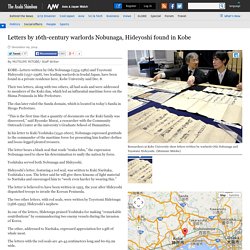
Their two letters, along with two others, all had seals and were addressed to members of the Kuki clan, which led an influential maritime force on the Shima Peninsula in Mie Prefecture. The clan later ruled the Sanda domain, which is located in today’s Sanda in Hyogo Prefecture. “This is the first time that a quantity of documents on the Kuki family was discovered,” said Ryosuke Murai, a researcher with the Community Outreach Center at the university’s Graduate School of Humanities. In his letter to Kuki Yoshitaka (1542-1600), Nobunaga expressed gratitude to the commander of the maritime force for presenting him leather clothes and loose-legged pleated trousers.
Yoshitaka served both Nobunaga and Hideyoshi. Hideyoshi’s letter, featuring a red seal, was written to Kuki Naritaka, Yoshitaka’s son. Forgotten Facts About Oda Nobunaga: Page 1. The utterly nonsensical habit of having tea ceremonies (I'm speaking for you here) had been a sensible item among the hordes of rigid rituals routinely infected the periods in Japanese history since the Heian era (click here for story & pictures of it), but it got suddenly transformed into a major diversion in the midst of the 'Warring States Period' of 16th century.
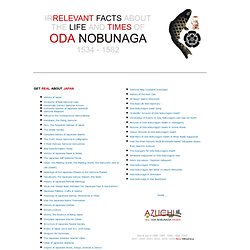
It's funny that even historians are still asking why so. Exactly because the age was so overwhelmingly turbulent, a few minutes out of this world -- which was a tea-related thing was all about -- became all the rage. It was perfectly illogical but (and) absolutely punctual like the meltdown of Windows operating system in 21st century. And Oda Nobunaga was the one who made tea-related stuff -- and all sorts of the usually impractical visual arts -- functional in the realm of feudal politicking since 1568. Yasuke: The African Samurai. Japan is not a place one would usually associate with immigrants from Africa or the Caribbean.

Yet in the late 16th century Japan’s most powerful warlord, Oda Nobunaga, had a black page who was not only a cultural curiosity but also served as Nobunaga’s bodyguard and was granted the prestigious rank of Samurai. This was a time of incessant warfare as the Ashikaga Shogunate fell and Japan became a war-torn nation with each tribe vying for control of against rival warlords.
Best of 2013: Nanban Art and Missionary Painters... The Alteration of the Image – Women and Japanese Society (1600-2000) Sex and Suffering: The Tragic Life of the Courtesan in Japan’s Floating World. It’s difficult to get a window into the world of Edo-Period Japanese prostitutes without the gauzy romantic filter of the male gaze.
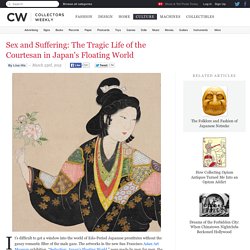
The artworks in the new San Francisco Asian Art Museum exhibition, “Seduction: Japan’s Floating World,” were made by men for men, the patrons of the Yoshiwara pleasure district outside of Edo, which is now known as Tokyo. YOUNG KAMIKAZE. Hiroshima. I—A Noiseless Flash At exactly fifteen minutes past eight in the morning, on August 6, 1945, Japanese time, at the moment when the atomic bomb flashed above Hiroshima, Miss Toshiko Sasaki, a clerk in the personnel department of the East Asia Tin Works, had just sat down at her place in the plant office and was turning her head to speak to the girl at the next desk.
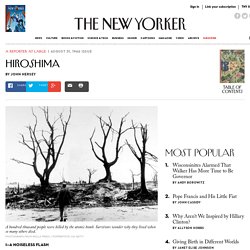
At that same moment, Dr. The Japanese women who married the enemy. Seventy years ago many Japanese people in occupied Tokyo after World War Two saw US troops as the enemy.

But tens of thousands of young Japanese women married GIs nonetheless - and then faced a big struggle to find their place in the US. For 21-year-old Hiroko Tolbert, meeting her husband's parents for the first time after she had travelled to America in 1951 was a chance to make a good impression. She picked her favourite kimono for the train journey to upstate New York, where she had heard everyone had beautiful clothes and beautiful homes. “The Only Woman in the Room”/ How The Amazing Beate Wrote Equal Rights For Women Into Japan’s Constitution.
“The Only Woman in the Room”/ How The Amazing Beate Wrote Equal Rights For Women Into Japan’s Constitution Posted by Kaori Shoji on Thursday, February 19, 2015 · 3 Comments Unanswerable questions of the year: Is Japan really going to war?
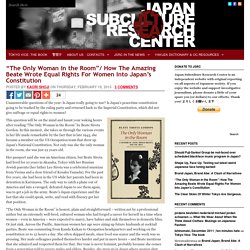
Is Japan’s peacetime constitution going to be trashed by the ruling party and returned back to the Imperial Constitution, which did not give suffrage or equal rights to women? The Japanese Diplomat Who Saved Thousands from the Holocaust. You can learn a lot about a person by seeing how they act under pressure, in tough situations.
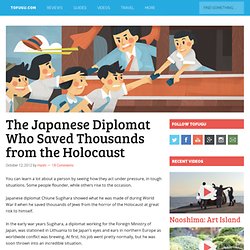
‘Visas for Life’ that saved Jews from Holocaust to be submitted for UNESCO inclusion. YAOTSU, Gifu Prefecture--Lists of transit visas issued by a Japanese diplomat to European Jews allowing them to escape Nazi persecution during World War II will be recommended for inclusion in UNESCO’s Memory of the World Program.
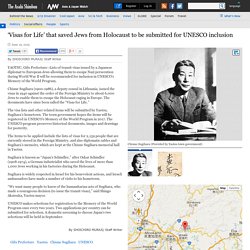
Chiune Sugihara (1900-1986), a deputy consul in Lithuania, issued the visas in 1940 against the order of the Foreign Ministry to about 6,000 Jews to enable them to escape the Holocaust raging in Europe. The documents have since been called the “Visas for Life.” The visa lists and other related items will be submitted by Yaotsu, Sugihara’s hometown. The Afterlife of a Poisonous Wife: Japan’s Famous O-Den Takahashi. Some criminals live on as legends for many years after their demise.
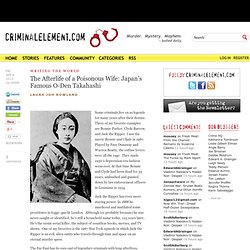
Three of my favorite examples are Bonnie Parker, Clyde Barrow, and Jack the Ripper. I saw the movie Bonnie and Clyde in 1967. Played by Faye Dunaway and Warren Beatty, the outlaw lovers were all the rage. They made 1930’s depression-era fashion seem cool. Designer Kenji Ekuan, known for Kikkoman soy sauce bottle, dies at 85. Japanese industrial designer Kenji Ekuan, whose works ranged from a bullet train to the red-capped Kikkoman soy sauce dispenser as familiar as the classic Coca-Cola bottle, has died, his company said. He was 85. A former monk, Ekuan crafted a tabletop bottle for Kikkoman Corp. in 1961, winning international popularity both for the handy, flask-shaped dispenser and of course for the salty brown condiment flavoring many Asian cuisines. He has said he wanted to design a small bottle because of his childhood memory of his mother pouring soy sauce from a big half-gallon bottle to a tabletop dispenser.
His renowned works also include the Yamaha VMAS motorcycle, the Komachi bullet train connecting Tokyo and northern Japan, the Narita Express airport liner, as well as audio equipment and company logos. Midnight Eye feature: The Realism of Fantasy: A Tribute to Fujio Morita. The late Fujio Morita (1927 – 2014) was among Japan’s cinema’s greatest cinematographers, alongside Kazuo Miyagawa (Ugetsu) and for instance Chikashi Makiura (Lone Wolf and Cub).
He straddled the Golden Age of the major film studios and the independent era following the collapse of Daiei in 1971, lensing films for such directors as Kenji Misumi, Kazuo Mori, Hideo Gosha (with whom he made 13 films, including Hitokiri), and actor-producer-director Shintaro Katsu. Zatoichi: A Lover's Suicide Song. Pioneering beautician Aguri Yoshiyuki dies at 107. Midnight Eye feature: Remembering Donald Richie (1924 – 2013) In Paul Schrader’s words, "Whatever we in the West know about Japanese film, and how we know it, we most likely owe to Donald Richie". If Richie spearheaded – or, more accurately, constituted – the first generation of Western writers on Japanese cinema, then the makers of this website could be said to represent a third. A generation that, unlike the second wave of Tony Rayns, Mark Schilling, Ian Buruma, Max Tessier et al, received their Richie influence in arguably more indirect ways.
His passing is not only an occasion for Midnight Eye to pay tribute to Donald Richie, but also to investigate that influence and how it has resonated through the decades – and will doubtlessly continue to resonate for many decades to come. Donald Richie remembered by: (With special thanks to Karen Severns and Emiko Namikawa.) Jasper Sharp. Going West to Find the “East”: Japanese Architect Itō Chūta’s Travel Throughout the Ottoman Lands (1904-05)” Demo held marking 30 years since murders of Sanya documentary activist-filmmakers Mitsuo Satō and Kyōichi Yamaoka.
A demo was held recently to mark three decades since the murders of activist-filmmakers Mitsuo Satō and Kyōichi Yamaoka. Satō had been filming a documentary about Sanya, the day labourer slum district (yoseba) in Tokyo, when he was filming in December 1985 at the age of 37. He was stabbed to death by a member of a Yakuza gang, who control the slums, possibly mistaken for a leftist activist from a group that had attacked the gang’s office.
However, merely by the act of turning on his camera, Satō was arguably an activist as much as filmmaker. Diplomatic documents show U.S. wanted changes to Sato's speeches in Okinawa visit in 1965. U.S. officials were clearly anxious about what then Prime Minister Eisaku Sato would say publicly in 1965 during the first visit to Okinawa by a Japanese prime minister since World War II, according to newly released documents. The picture of concerned U.S. officials is what emerges from the diplomatic documents, released Jan. 15, which detail the interaction with their Japanese counterparts in the days before Sato's arrival on Aug. 19 of that year. Okinawa was then under the administration of the United States, and negotiations had not yet begun in earnest about returning it to Japan.
Okinawa would eventually be returned to Japanese control in 1972. In a speech given by Sato at Naha Airport upon arrival, he said, "I understand very well that the 'postwar' era for Japan will not come to an end until Okinawa returns to the homeland. " Two days before his scheduled visit, the U.S. Toshiro Mifune to get star on Hollywood Walk of Fame. Midnight Eye review: The Sun’s Burial (Taiyo no Hakaba, 1960, Nagisa OSHIMA) Midnight Eye feature: Hideo Gosha: The Manly Way. Midnight Eye feature: Hideo Gosha Part 2: The Will To Live. Hideo Gosha on set in 1978 Between 1974 and 1978, Hideo Gosha was unable to pursue his filmmaking career and could only make documentary films for Fuji TV.
VOX POPULI: Kabuki world laments loss of graceful star Bando Mitsugoro X. France decorates 'butoh' choreographer Amagatsu with highest honor. Male geisha seeks to revive traditional entertainment world in Tokyo. The soul is bone - Meet Eitaro. The 26-year-old comes from a family... The Father of Street Photography in Japan. In 1972, Japanese photographer Daido Moriyama published a book called Shashin yo Sayonara, translated into English as Farewell Photography. Enigmatic and seemingly innocuous, the title actually summarised an entire, revolutionary photographic upheaval. Contrary to what his fellow American and European photographers were doing with their well-composed, beautifully toned and elegiac pictures, Daido Moriyama started experimenting with an anti-photographic style. Photo possibly of John Manjiro, first Japanese to live in U.S., with skipper found in Massachusetts library.
NEW YORK – An unpublished photo of a man who could be Nakahama Manjiro (1827-1898), the first Japanese known to have lived in the United States, has been found at a public library in Massachusetts. Nakahama, better known as John Manjiro, lived and studied in America after he was rescued by a U.S. whaling ship along with a few other fisherman colleagues when their fishing boat became stranded on an uninhabited isle in the Pacific Ocean in 1841. Japanese family watching over grave of Briton for 143 years finally learns who is buried there. Felix Seuffert // Photo & Film, Cape Town. Anthony luke's not-just-another-photoblog Blog: Photographer Iwase Yoshiyuki's Ama Divers ~ 1950's (and selected works) Voluntary human shield. Shunsuke Tsurumi, philosopher and leading anti-war activist, dies at 93. Shunsuke Tsurumi, a liberal philosopher who led postwar peace movements and protests against the Vietnam War, died of pneumonia at a hospital in Kyoto on July 20, his eldest son said July 24.
He was 93. Born in Tokyo in 1922 to influential politician Yusuke Tsurumi, the son entered Harvard University’s Department of Philosophy in 1939. In March 1942, after the Pacific War broke out, U.S. authorities accused Tsurumi of being an anarchist and arrested him. He returned to Japan on a wartime exchange ship, and then worked as a civilian employee for the Imperial Japanese Navy mainly as a translator and an editor for a naval intelligence paper for high-ranking officials in Indonesia.
A year after Japan’s surrender, he founded the Shiso no Kagaku (Science of thinking) magazine with leading economist Shigeto Tsuru and political theorist Masao Maruyama to introduce “pragmatism,” a philosophical tradition that originated in the United States. In recent years, Tsurumi publicly protested the U.S. Messages from victims of 1985 JAL crash still guide families 30 years later. In a final poignant act, Masakatsu Taniguchi scrawled a message to his family on an air sickness bag before JAL Flight 123 crashed on Aug. 12, 1985, the deadliest single-aircraft accident in history.
“Machiko, please take good care of our children,” Taniguchi, 40, wrote to his wife. Life of Japanese Anne Translator Dramatized » Anne of Green Gables. Why Anne of Green Gables Is Big in Japan